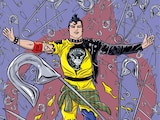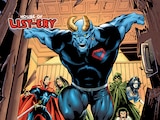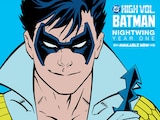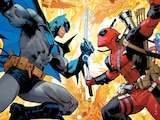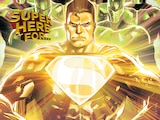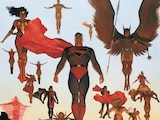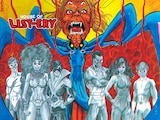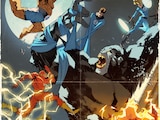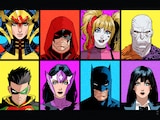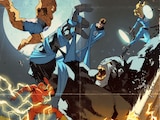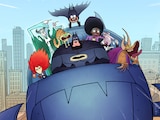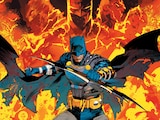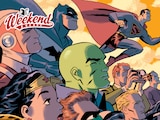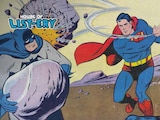Think being a superhero is tough? Try being the child of one.
Super Sons: The Polarshield Project is the debut title in DC Zoom, DC’s new line of middle grade graphic novels. Written by New York Times bestselling author Ridley Pearson (Kingdom Keepers) and drawn by artist Ile Gonzalez (The Heroes Club), this standalone series introduces us to an entirely new version of the Super Sons, completely unlike anything we’ve seen before. Set in the not-too-distant future, where the world is suffering the devastating effects of climate change, Super Sons: The Polarshield Project tells the story of how the son of Superman and son of Batman first met, set against a dramatic backdrop of mystery, conspiracy…and middle school drama!
It’s a unique, vastly different take on the DC Universe and the children of its two greatest heroes, and it hits on some pretty serious themes for a middle grade book. But with Pearson and Gonzalez at the helm, The Polarshield Project does it without sacrificing any of the fun usually associated with Jon Kent and Damian Wayne. Striking a balance between real world issues, youthful misadventures and high stakes superhero fantasy is no easy task, but it’s the sort of thing Pearson thrives at, who makes his graphic novel debut on Polarshield, an ambitious project set in an alternate world that still seems very familiar. Pearson recently sat down with us for a conversation on reimagining characters, artistic collaboration and bringing real-world issues to middle grade fiction. Along the way, he teased some of the mysteries to come in the series, revealed which part of the plot is actually drawn from real life and explained why, in this book, Damian goes by “Ian.”

You’ve written dozens of books, including quite a few for younger readers, but Super Sons: The Polarshield Project is your first graphic novel. Was writing a graphic novel series something you’d had interest in doing?
I’ve always been interested in it because it reaches a different audience. With some of my children’s novels, I’d asked if we couldn’t do them as graphic novels, but the different companies that I was working with always put it off for one reason or another. I love a new project and a new challenge, and when DC asked me about this and explained that these are written in script form, I kind of went crazy because I love writing scripts. So, it really fit into something I loved to do and off I went.
You’re working with Ile Gonzalez on this, who actually has experience drawing middle grade comics. What was your collaborative process like with her?
I work through DC with Ile. I think what is unique about graphic novels for a novelist is that when I’m writing , I’m using my words to try to put an image and emotion in you as a reader. And when I’m working as a graphic novel writer, I’m trying to use my words to put an image and emotion into a person—Ile Gonzalez—who’s then going to act as a medium and translate that to this visual language that’s static and sits on a page. Really, the less text is better. So, I will write a page to Ile about what I’m seeing, how they’re feeling and what they’re doing, then she has this genius ability to be able to capture that in a very simple, fun image. But it’s very different for me because instead of letting words pour out and flow, which is what you do as a novelist, you need to use very few words and make them very precise. Let it all land on the page accurately.

Like many of the DC Zoom books, Super Sons reimagines these characters and their world from the ground up. How did these versions of Jon Kent and Damian Wayne come together?
They let me world build, so I spent four months building the world the Super Sons would exist in before I even dealt with them. I wanted to tweak Damian a little because at that point in the DC world, he was basically a 12-year-old assassin and in this climate in schools, that’s not a great vibe to put out there. DC was kind enough to allow to do what I want and reinvent him. I also grew up in an era where every weird slasher in a horror movie was named “Damian,” and I just couldn’t even confront the name Damian on the page, so I pulled “Ian” out of his name as a nickname and it ended up Jon and Ian.
I talked a lot to Ben Abernathy about the backstory within the DC Universe, and where I needed to adhere to the canon and where I could wander from it. I wanted to make these guys rivals at first. Ian probably envies Jon’s superpowers. He even mentions them throughout the book—“Whoa, you can do that?!” Jon, I would say, admires Damian’s pluckiness and how he’s this unapologetic, brash, very daring kid. The two can both get something from each.
What can you tell us about their world? It’s quite different than the one that some readers may be used to.
It’s probably 10-15 years into the future. Maybe 20 or 30 depending on your optimism. The world is under climate disruption. Wayne Enterprises has started to build levees and retaining barriers around big cities like Metropolis and Gotham, but there’s a gang who’s trying to profit off the suffering of people who are experiencing the effects of climate change, so they’re sabotaging all of Bruce Wayne’s efforts. That’s kind of one thread—that’s the Batman and Superman thread. At the same time, in the first book, Jon and Ian are trying to uncover a plot that has left Lois Lane poisoned by a virus. It’s not until those two stories converge that the boys understand the challenges they face. They really are trying to save the world in a different kind of way than beating some evil genius.

With issues like climate change becoming worldwide concerns, do you think it’s important that books aimed at younger readers address real world problems?
I do it throughout my books. I’ve written fiftysomething books and the mysteries all have some kind of social issue that percolates. I don’t like hitting people over the head with a hammer about it. My deal as a reader is that I like to learn something as well as be entertained. In Super Sons, there are a few themes that I want to deal with. One is name calling and immigration. In the book they call anybody who migrates into an inland city a “flood runner,” and it’s a disparaging term. It’s not really bullying, but it’s nasty and nobody needs to do that stuff.
Now, the Polarshield is real. There’s a team of fifty international scientists considering dusting the atmosphere over both poles with sulfur dust to shield the ice. They think that if they do this correctly, they can lower the temperatures by about 1.5 degrees Centigrade. When I read about that, I thought, “Well, that’s the world we’re in. This new Polarshield thing is in place and somebody’s trying to sabotage it.”
While the title may focus on the Super Sons, they’re not the only ones with a prominent role in the book. What can you tell us about Candace? There’s a mystery around her, it seems.
Well, my wife, Marcelle, and I have girls. When I talked to DC about this, I said that I’d really like a girl to be in the story because I’m more comfortable writing about young girls than writing about my past as a guy running around in my backyard throwing onion grass. We also have a quasi-adopted son from Kenya, so I was going to make her a young girl from Africa. Then I did a bunch of research, and in ancient Africa there was a string of Candaces in a Nubian Empire that’s below Egypt. Every empress was named Candace—it was handed down to the first born. They led a male and female army, and these were vicious, amazing warriors. When the Romans invaded Egypt, this army went down the Nile and drove them out. That’s how powerful they were. The most feared army in the world was defeated by this army led by a woman named Candace. So, I made our Candace a part of that legacy—she just doesn’t understand it yet. Her arc is to figure out who she is and this greatness that awaits her.

Do you think it’s more challenging to be a superhero or the child of a superhero?
Oh, I think a child of a superhero. I don’t really follow golf, but the other day, I was watching Jack Nicklaus’s grandson at the Masters Par 3 Contest hit a hole-in-one and I thought about him trying to live up to his grandfather’s reputation. I think that Jon’s problem is that we all want to be the apple of our dad’s eye, but his dad is Superman. He can bend steel. He can fly. Jon is half-human. He has to deal with the fact that in our world, he’s strong, but he’s never going to bend steel. He can jump insane distances, but he’s never going to fly. He can see and hear far better than other people, but will his dad think less of him because he doesn’t have his capabilities? Those ideas intrigue me, and I think it’s important for kids to understand that they’re really fine as they are. They’re great as they are.
Ian is this sort of abandoned kid. He doesn’t know his mother. His father is rich and always traveling. He’s been raised by nannies and hangs out with his dad’s assistant. He would love some kind of nuclear family. His thing is more abandonment—why can’t I be my father’s Robin? That’s his whole thing. But Batman knows how rough this is. He’s thinking, “No way are you going to be my Robin!”
Of course, he will be his Robin eventually.

In The Polarshield Project, the Super Sons unearth a conspiracy hidden within a plan to save the planet from global warming. Where do things go in the next book in the series, The Foxglove Mission?
The second book sets Candace on her journey, and the boys narrow in and identify what Lois’s sickness is all about. And again, those seemingly separate worlds—it all begins to look like some kind of joint sine wave. The worlds are apart, and they cross. And then they’re apart and they cross again. It’s all narrowing things down to where by the third book, they’re all on a single line.
Super Sons: The Polarshield Project by Ridley Pearson and Ile Gonzalez is now available in bookstores, comic shops and as a digital graphic novel.


